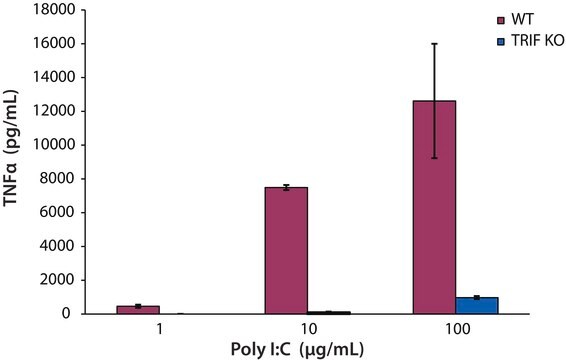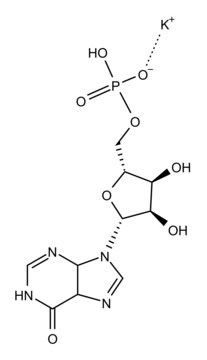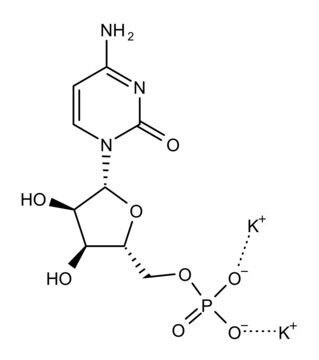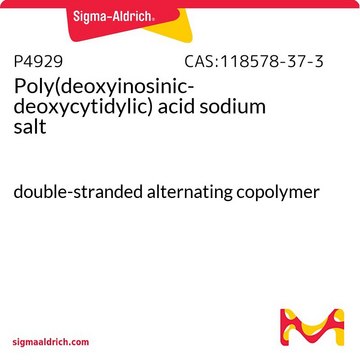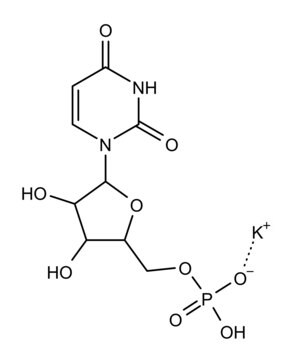P9582
Polyinosinic–polycytidylic acid potassium salt
with buffer salts, TLR ligand tested
Synonym(s):
Poly (I:C), Poly(I) • Poly(C)
Sign Into View Organizational & Contract Pricing
All Photos(4)
About This Item
Recommended Products
Quality Level
Assay
≥99% (less than 1% free nucleotides, TLC)
form
lyophilized powder
composition
Poly(I) • Poly(C), 10% (balance buffer salts as sodium chloride and sodium phosphate)
storage condition
desiccated
storage temp.
−20°C
Looking for similar products? Visit Product Comparison Guide
Application
TLR3 recognizes double-stranded RNA and is a major effector of the immune response against viral pathogens. Polyinosinic–polycytidylic acid (Poly(I) • Poly(C)) is a double-stranded homopolymer used as a model RNA to study cell signaling at the level of TLR3. Poly(IC) is a TRIF-dependent toll-like receptor-3 (TLR3) ligand.
Biochem/physiol Actions
Transfection of Poly (I:C) into NIT-1 cells has been used as a model of intracellular dsRNA-induced β cell apoptosis. Eighteen hours post transfection, 45% of the cells were apoptotic with an increase in NF-kB, p50/p65 nuclear translocation, and cleavage of caspases 3 and 8, as well as transcriptional induction of caspase 12, Fas, IL-15, and the TNF receptor-associated ligand (TRAIL). It has been suggested that Poly(I:C) is one of the most appropriate generators of stable mature dendritic cells (DC). These mature DC might generate in vivo effective immune responses after injection due to their ability to secrete bioactive IL-12 after CD40 ligation. Poly (I:C) was used as a potent adjuvant to enhance the specific anti-tumor immune responses against a peptide-based vaccine.
Packaging
Package size based on polynucleotide content
Other Notes
Double-stranded homopolymer.
Preparation Note
The product requires ionic strength to maintain the double-strand structure. Reconstitution at ~10 mg/mL of water yields a polynucleotide in physiological phosphate buffered solution.
Storage Class Code
11 - Combustible Solids
WGK
WGK 3
Flash Point(F)
Not applicable
Flash Point(C)
Not applicable
Personal Protective Equipment
dust mask type N95 (US), Eyeshields, Gloves
Choose from one of the most recent versions:
Already Own This Product?
Find documentation for the products that you have recently purchased in the Document Library.
Customers Also Viewed
Marie Anaïs Labouesse et al.
Epigenetics, 10(12), 1143-1155 (2015-11-18)
Maternal infection during pregnancy increases the risk of neurodevelopmental disorders in the offspring. In addition to its influence on other neuronal systems, this early-life environmental adversity has been shown to negatively affect cortical γ-aminobutyric acid (GABA) functions in adult life
Wei-Li Wu et al.
Brain, behavior, and immunity, 62, 11-23 (2016-11-14)
Epidemiological studies show that maternal immune activation (MIA) during pregnancy is a risk factor for autism. However, mechanisms for how MIA affects brain development and behaviors in offspring remain poorly described. To determine whether placental interleukin-6 (IL-6) signaling is required
Jun-Sang Sunwoo et al.
Annals of clinical and translational neurology, 5(10), 1264-1276 (2018-10-24)
Maternal immune activation (MIA) is associated with an increased risk of autism spectrum disorder (ASD) in offspring. Herein, we investigate the altered expression of microRNAs (miRNA), and that of their target genes, in the brains of MIA mouse offspring. To
Halime Kalkavan et al.
Nature communications, 8, 14447-14447 (2017-03-02)
Immune-mediated effector molecules can limit cancer growth, but lack of sustained immune activation in the tumour microenvironment restricts antitumour immunity. New therapeutic approaches that induce a strong and prolonged immune activation would represent a major immunotherapeutic advance. Here we show
William R Crum et al.
Brain, behavior, and immunity, 63, 50-59 (2016-12-13)
Genetic and environmental risk factors for psychiatric disorders are suggested to disrupt the trajectory of brain maturation during adolescence, leading to the development of psychopathology in adulthood. Rodent models are powerful tools to dissect the specific effects of such risk
Our team of scientists has experience in all areas of research including Life Science, Material Science, Chemical Synthesis, Chromatography, Analytical and many others.
Contact Technical Service